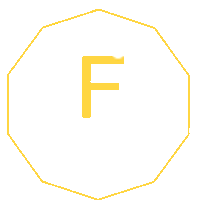Fluorine
Atomic mass:18.998 u

Fluorine is a fascinating and highly reactive chemical element. Here’s a detailed overview of its properties, uses, and other interesting facts:
Basic Properties
- Symbol: F
- Atomic Number: 9
- Atomic Weight: Approximately 18.998403163
- Classification: Halogen
- State at Room Temperature: Gas
- Electron Configuration: [He] 2s² 2p⁵
- Melting Point: -219.67°C (-363.41°F)
- Boiling Point: -188.11°C (-306.6°F)
- Density: Approximately 0.001696 g/cm³ at 0°C and 101.325 kPa
Physical and Chemical Properties
- Fluorine is the most electronegative and reactive of all elements. It is a pale yellow gas at room temperature.
- It readily forms compounds with most other elements, even with the noble gases xenon, krypton, and radon under certain conditions.
- Due to its high reactivity, elemental fluorine (F₂) is produced industrially by the electrolysis of a solution of hydrogen fluoride (HF) in potassium fluoride (KF), which is called the Fowler process.
Occurrence
- Fluorine does not occur free in nature due to its reactivity but is found in various minerals such as fluorite, cryolite, and apatite.
- The most commercially significant fluorine mineral is fluorite (calcium fluoride), which is used as a flux in metal smelting and as a source of fluorine for hydrofluoric acid production.
Uses
- Industrial Applications: Fluorine is primarily used in the form of its various compounds. Hydrofluoric acid (HF) is an important industrial chemical used to etch glass and to process certain ores.
- CFCs and Refrigerants: Fluorine is a component in the manufacturing of chlorofluorocarbons (CFCs) historically used in air conditioning and refrigeration systems, although their use has declined due to environmental concerns.
- Pharmaceuticals and Agrochemicals: Several pharmaceuticals and agrochemicals contain fluorine, including several of the most widely used drugs, due to its ability to enhance chemical stability and bioavailability.
- Dental Care: Fluoride, a compound of fluorine, is added to toothpaste and water supplies to prevent dental cavities.
- Teflon Production: Polytetrafluoroethylene (PTFE), better known as Teflon, is a synthetic fluoropolymer of tetrafluoroethylene that has numerous applications, notably in non-stick cookware.
Health and Environmental Impact
- Toxicity: Elemental fluorine and hydrofluoric acid are extremely toxic and corrosive. Fluorine gas is dangerous to inhale, and hydrofluoric acid can cause severe chemical burns and systemic toxicity.
- Fluoridation of Water: The addition of fluoride to public water supplies to prevent tooth decay has been both lauded for its dental benefits and criticized by some who cite potential health risks. The consensus in the medical community is that fluoride in low concentrations does not cause harm and is beneficial for dental health.
- Environmental Concerns: Compounds containing fluorine, such as CFCs, have significant environmental impacts. CFCs, for example, are potent greenhouse gases and have contributed to ozone depletion, although their production has been largely phased out under international agreements like the Montreal Protocol.
Interesting Facts
- Fluorine was isolated by the French chemist Henri Moissan in 1886, for which he was later awarded the Nobel Prize in Chemistry.
- Due to its extreme reactivity, fluorine forms compounds with all elements except helium and neon.
- Fluorine’s extreme reactivity also makes it difficult to handle and store, requiring special equipment and precautions.
What is the atomic number of fluorine?
- Answer: 9
What is the chemical symbol for fluorine?
- Answer: F
At room temperature, what is the state of fluorine?
- Answer: Gas
Why is fluorine so reactive?
- Answer: Fluorine is extremely reactive due to its high electronegativity and small atomic size, which allows it to easily attract electrons from other elements.
What color is fluorine gas?
- Answer: Pale yellow
What is fluorine’s place on the periodic table?
- Answer: It is in Group 17, known as the halogens.
What is the atomic weight of fluorine?
- Answer: Approximately 18.998
How is fluorine produced industrially?
- Answer: Through the electrolysis of hydrogen fluoride in the presence of potassium fluoride.
What are the primary uses of fluorine?
- Answer: In the production of refrigerants, pharmaceuticals, and agrochemicals, and in the treatment of water to prevent dental cavities.
What is the boiling point of fluorine?
- Answer: -188.11°C
What is the melting point of fluorine?
- Answer: -219.67°C
What type of bonding does fluorine commonly form?
- Answer: Fluorine commonly forms ionic or covalent bonds.
What are some common compounds of fluorine?
- Answer: Hydrofluoric acid (HF), sulfur hexafluoride (SF6), and various fluorocarbons.
How does fluorine interact with water?
- Answer: Fluorine reacts vigorously with water to form oxygen and hydrofluoric acid.
Is fluorine found in nature?
- Answer: Yes, but only in compound form, such as in fluorite, cryolite, and apatite.
Can fluorine be found in biological organisms?
- Answer: Yes, in trace amounts, essential for the durability of bones and teeth.
What safety precautions are necessary when handling fluorine?
- Answer: Use of specialized protective gear, proper ventilation, and rigorous procedural protocols are essential due to its corrosive nature.
What are the health risks associated with fluorine exposure?
- Answer: Fluorine gas can be highly toxic to the lungs, and hydrofluoric acid can cause severe chemical burns and systemic toxicity.
Why is fluorine added to public water supplies?
- Answer: To reduce dental decay by converting hydroxyapatite in teeth into more decay-resistant fluorapatite.
What is dental fluorosis?
- Answer: A cosmetic condition that results from excessive fluoride intake and causes discoloration or mottling of the teeth.
How does fluorine react with organic compounds?
- Answer: It can react violently, replacing hydrogen atoms in hydrocarbons to form fluorocarbons.
What is the role of fluorine in nuclear energy?
- Answer: It is used to produce uranium hexafluoride, which is required in the process of uranium enrichment.
How is fluorine stored?
- Answer: In cylinders made from nickel or Monel, which can withstand the corrosive effects of fluorine.
What are fluoropolymers?
- Answer: Polymers containing fluorine, like Teflon, known for their high resistance to solvents, acids, and bases.
How does fluorine affect the ozone layer?
- Answer: Fluorine itself does not affect the ozone layer, but some fluorine-containing compounds like CFCs have been known to deplete ozone.
Why is hydrofluoric acid particularly dangerous?
- Answer: It can penetrate skin, causing deep tissue damage and systemic toxicity, including potentially fatal heart arrhythmias.
What is the electron configuration of fluorine?
- Answer: [He] 2s² 2p⁵
What is the role of fluorine in PET scans?
- Answer: Fluorine-18, a radioactive isotope, is used in the tracer fluorodeoxyglucose for positron emission tomography (PET) scans.
How does fluorine react with metals?
- Answer: It reacts vigorously with most metals, forming fluorides.
What is the impact of fluorine on the environment?
- Answer: Fluorine compounds can persist in the environment and may contribute to pollution if not managed correctly.
What is the difference between fluorine and fluoride?
- Answer: Fluorine is the element, and fluoride refers to its ionic form or compounds containing the fluoride ion.
What are some naturally occurring sources of fluoride?
- Answer: Natural sources include fluorite, cryolite, and seawater.
How is fluorine used in fire suppression?
- Answer: Certain fluorine-containing compounds are used in fire extinguishers, especially for electrical fires.
What role does fluorine play in refrigerants?
- Answer: Fluorine is used in the manufacture of hydrofluorocarbons (HFCs) and hydrochlorofluorocarbons (HCFCs), which are used as refrigerants.
What is the significance of fluorine in organic chemistry?
- Answer: Fluorine is used to modify the properties of organic compounds, enhancing their stability and altering their reactivity.
What legal regulations exist for fluorine usage?
- Answer: Various international and national regulations govern the use and disposal of fluorine and its compounds, particularly those that impact the environment and public health.
Can fluorine exist in different isotopic forms?
- Answer: Yes, there are several isotopes of fluorine, but fluorine-19 is the only stable and naturally occurring isotope.
What precautions are necessary for transporting fluorine?
- Answer: Due to its highly reactive and corrosive nature, fluorine must be transported in specially designed and certified containers.
What is the use of fluorine in aluminum production?
- Answer: Fluorine compounds like cryolite act as a flux to lower the melting point of alumina in the production of aluminum.
What recent advances have been made in fluorine chemistry?
- Answer: Recent advances include the development of new fluorinated pharmaceuticals, environmentally friendly refrigerants, and improved methods for safely handling and recycling fluorine-containing products.






